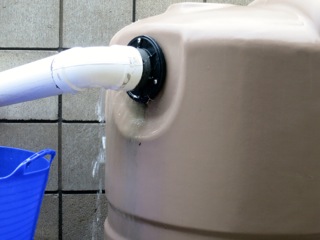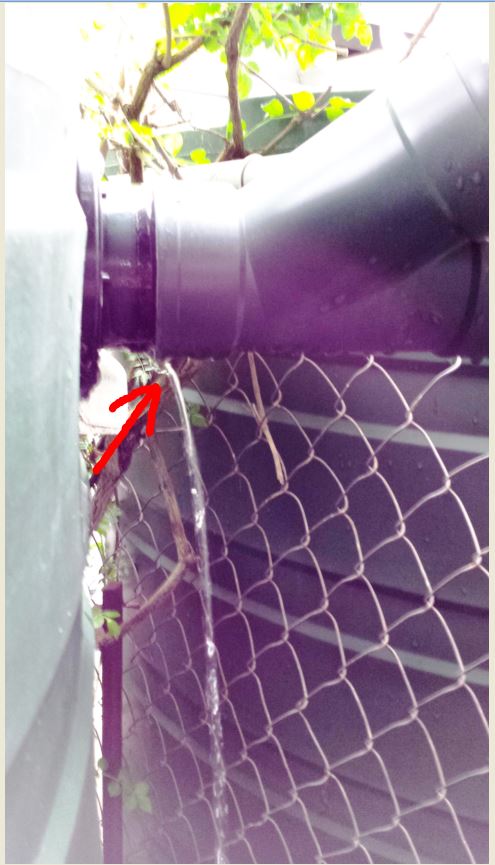You don’t have a problem! You just need another tank because your tank is OVERFLOWING and we are only halfway through the rainy season!
Any tanks that get installed after April haven’t likely filled until now, so this time of year is an exciting one to see how everything works! Some of you are surprised your tank filled so quickly. Others have already experienced rain volumes filling trash cans and 55 gallon drums in a matter of minutes, so they aren’t surprised when 500 gallons or even 1500 gallons fills in a single rain event!

Once tanks start filling with water, they may settle and shift, so we may see some unexpected results. This particular joint is the overflow. Generally, I prefer not to glue pipes onto this joint in case we ever need to reconfigure or clean your rainwater tank. I have reconfigured several tank setups from installers who had glued the joint and it makes it hard to do things like daisy chain tanks, or configure new overflow routing once an elbow is glued in a particular direction. If the elbow is placed far enough on this joint, you shouldn’t see a leak.
We often see some water leaking from behind the black gasket where the fitting is fastened to the tank. This doesn’t mean you are losing water since your tank is already full and this water is going to overflow anyway. So unless the volume is extreme, this is not necessarily a sign that you need to fix anything. If the volume is concerning, or your tank is placed in a location which is sensitive to this drip, here are a couple things you can do:
- hand tighten these screws (a driver/drill may strip the screws)
- use silicon to help seal around the gasket (make sure everything is dry so the silicon will seal)
- open up the lid of the tank and look inside to see if the screen at the overflow is clogged from the inside. I have seen a couple instances of this this year where there was insufficient prefiltering for the roof material and small clay particles or rock dust floated to the top when the tank filled and clogged the overflow screen. This was fixed by removing the material with our hands, or spraying it clear with a hose after the water level went down.
- if the drip is extreme or none of the above fixes the problem, you may consider requesting a new fitting for the tank.

This is a more extreme leak at an overflow joining two tanks. Here is a case where the filled tanks have shifted and the pipe needs to be pushed back onto the overflow joints
We love hearing from clients of H2OME, clients of other installers, and homeowners who are troubleshooting their own installations! The more we see how these systems perform over time, the more information we will have to share! Tell us what is working and what isn’t! After installing hundreds of thousands of gallons of water storage, with hundreds of tanks ranging in size from 205 gallons to 5050 gallons throughout Southern California, H2OME is leading the local industry in experience with these simple systems. We thrive on sharing our knowledge and experience with you!
If you are excited to see your tank overflowing and wanting to get the next tank in place to store more water for the long dry season, give us a call or send us an email! We love to see gardens thriving in the summer time without guilt!
